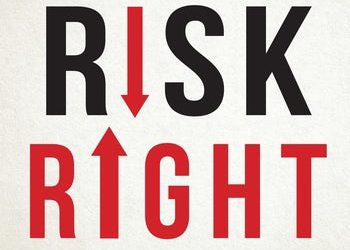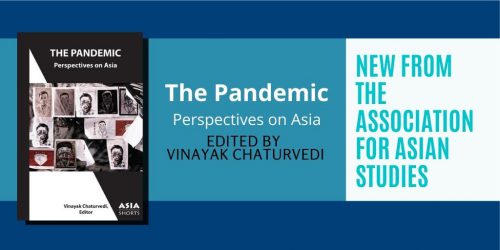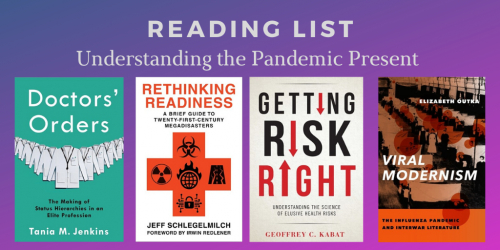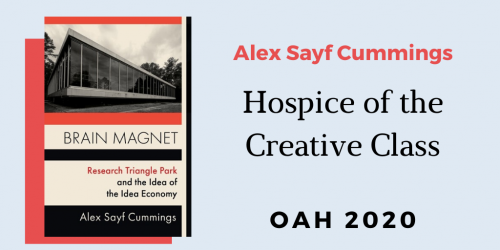Why It Takes More Than Stockpiling Supplies and First Responder Training to Prepare for Megadisasters Jeff Schlegelmilch
Jeff Schlegelmilch
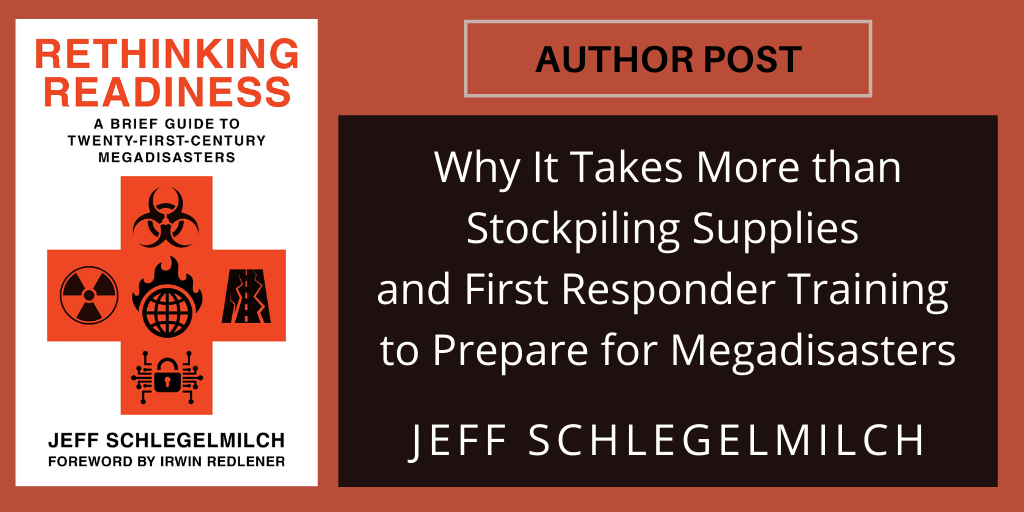
“This timely book both looks ahead to the mega-disasters on the horizon—disasters that tank economies, shred infrastructure, and take lives—and outlines how communities can start preparing now. It is an essential guide for policy makers and concerned citizens alike who want to build a better future.”
~Alice C. Hill, former senior director of resilience policy on the National Security Council
As human society continues to develop, we have increased the risk of large-scale disasters. From health care to infrastructure to national security, systems designed to keep us safe have also heightened the potential for catastrophe. In this post, Jeff Schlegelmilch, author of Rethinking Readiness: A Brief Guide to Twenty-First-Century Megadisasters, introduces us to his new book and the complexities in preparing for future disasters.
• • • • • •
After the 9/11 terrorist attacks, we were on a mission to make sure everyone was ready to fend for themselves for at least seventy-two hours after a disaster until help arrives. We told people to make sure they have adequate food, water, essential medicines, and maybe even get some plastic and duct tape to seal off their windows in the event of a terrorist’s chemical attack. After the devastation and slow response to Hurricane Katrina, this message shifted to having a week or more of supplies. The need to plan for children and pets also became urgent. Some even suggested having an ax in your preparedness kit in case you needed to chop your way out of your attic onto your roof if you were trapped in your house because of rising floodwaters.
These simple, actionable steps we advise people to take have been the cornerstone of preparedness in the United States since the 9/11 attacks and were reflected in the equivalent guidance for agencies and in our policies. Stockpile drugs, buy supplies, and plan, plan, plan. Inordinate sums have been invested in promoting these steps, and they have been adopted as common sense across preparedness institutions, creating new opportunities for consultants capitalizing on an industry periodically flush with taxpayer dollars. The problem is that, as a society, these measures don’t actually get us that much closer to achieving preparedness on their own. The context of our vulnerability and the threats we face are far more complex and permeate through all aspects of our development trajectory. We have started to get closer to acknowledging this complexity in recent years by rebranding preparedness with terms like resilience and sustainable development, and by taking whole community approaches, but we still have a long way to go.
“The context of our vulnerability and the threats we face are far more complex and permeate through all aspects of our development trajectory.”
My book, Rethinking Readiness: A Brief Guide to Twenty-First-Century Megadisasters, takes a high level view of five disaster scenarios we face that are driven by human activity. These are scenarios where societal development contributes to both the threat and the underlying vulnerability to disasters that include biothreats, climate change, critical infrastructure failure, cyberthreats, and nuclear conflict. The book then looks at cross-cutting themes that are the root causes for our lack of readiness and what we can do about it as a society.
In dissecting each of these megadisaster scenarios, it becomes clear that disasters are not a distinct area of policy. Preparedness, resilience, readiness, or whatever nomenclature you prefer, is an ecosystem. It happens at the intersection of what makes up our society and at the convergence of such foundational societal structures as economics, infrastructure, health, equity, ecology, culture, and psychology. In some cases, social cohesion can be more predictive of who survives and who doesn’t than infrastructure, and the sustainable development we envision is often outpaced by short-term incentives to build and grow economies in ways that ignore the lasting dangers they impose on us all.
“Preparedness, resilience, readiness, or whatever nomenclature you prefer, is an ecosystem.”
And while this book is not intended to be an instruction manual for how to become prepared, it serves as a starting point for rethinking readiness at all levels of society. By reimagining the role of the emergency manager as more than the person who has to manage the consequences of the faulty policies they inherit, by transitioning our approaches from reductionist and deterministic checklists to embracing uncertainty in the face of the conditions that create disasters, we can build resilience with more than just our rhetoric.
In a world of COVID-19, systemic racism, and the increasing polarization of our politics, these dynamics are more important to understand than ever before. We are seeing progress toward eradicating diseases globally, blunted by the burden of COVID-19 on chronically underfunded public health systems. We are seeing the fragility of supply chains developed under the economics of efficiency and globalization. And we are seeing racial fault lines reaching a breaking point, with disproportionate impacts of COVID-19 on communities of color coupled by generations of policies that have denied communities the economic opportunities and freedom from fear that those only a few miles away enjoy with regularity. These few examples illustrate how the table is set for disaster response and recovery long before disasters occur.
“But we also need to break the cycle of increasing billion-dollar disasters in order to avoid the looming catastrophes on a scale only the history books foretell and no preparedness kit can get you ready for.”
We still require the expertise and specialization of our first responders to manage the consequences of disasters. But we also need to break the cycle of increasing billion-dollar disasters in order to avoid the looming catastrophes on a scale only the history books foretell and no preparedness kit can get you ready for. Having a week’s worth of food and an ax in a preparedness kit may help you in the event you need it. And, to be clear, personal preparedness, although currently lacking an evidence base, is probably still a good idea. But it won’t make us more prepared on its own or even reduce your risk of experiencing a disaster.
If the legacy of COVID-19 is to rebrand preparedness and to suggest you add more toilet paper to your preparedness kit, we will have again missed the point. But if this serves as an inflection point, where we look long and hard at reinventing obsolete approaches to managing disasters and myopic development strategies, we just might be able to build the kind of resilience that will benefit us across all types disasters and throughout our society.

